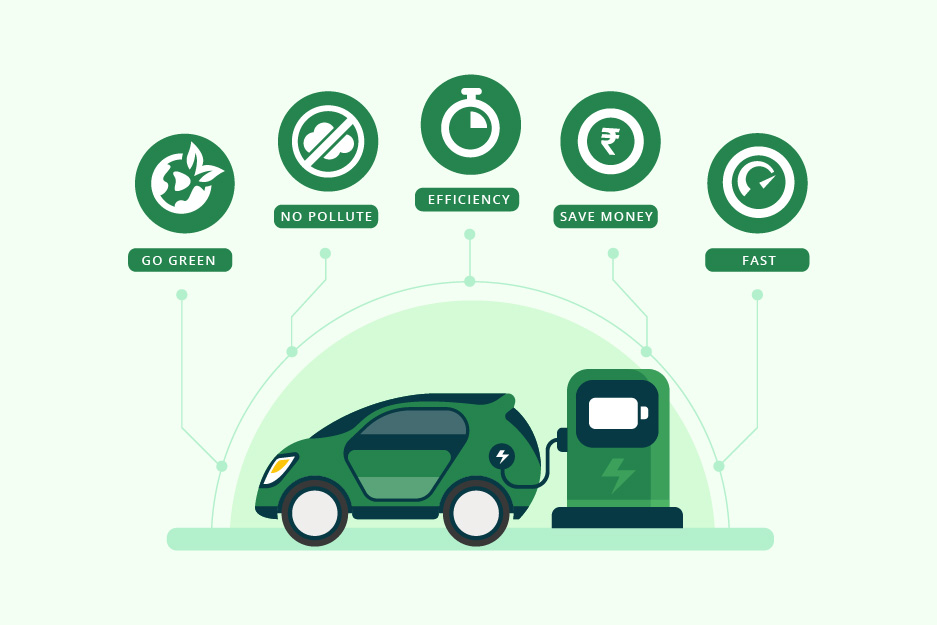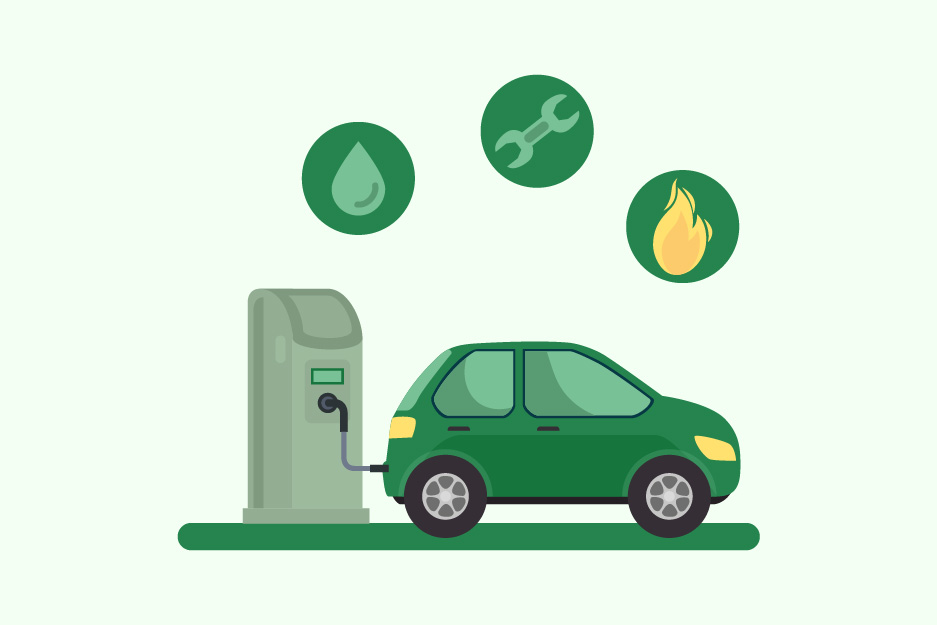10 Key Electric Vehicle Components: The 2025 Guide
Electric vehicles have gained immense popularity in recent years due to their several benefits. They offer a cleaner, quieter, and more efficient alternative to traditional gasoline-powered cars. However, have you ever taken a moment to think about the technology that powers an EV? Unlike their gasoline counterparts, EVs rely on a unique set of components to deliver a smooth and exhilarating driving experience. If you’re interested in learning more about EVs and pursuing a career in this field, consider enrolling in an electric vehicle course with placement. In this blog, we will delve into the 10 essential electric vehicle components and explore their functions.
Main Components of an Electric Vehicle
The electric car components play a vital role in delivering a clean, efficient, and powerful driving experience. They work in harmony to achieve a range of benefits that are not possible with traditional gasoline-powered vehicles. Here is the electric vehicle components list:
1. Traction Battery Pack
The traction battery pack is the backbone of an electric vehicle (EV) that stores and supplies the electrical energy required to power the electric motor. It is a rechargeable battery made up of numerous smaller battery cells linked together electrically.
The battery pack’s configuration depends on the overall power and voltage requirements of the electric motor, with the most common type of battery cell used in EVs being lithium-ion (Li-ion) batteries due to their high energy density and efficiency. The capacity of the traction battery pack directly affects the driving range of an EV and its ability to deliver power influences its performance.
2. Electric Motor
An electric motor is one of the main components of electric vehicle(EV). It converts the electrical energy stored in the car’s battery into mechanical energy, which propels the vehicle forward. Unlike gasoline engines that burn fuel to produce power, an electric motor uses electricity to create rotational force. The force generated is then transferred to the wheels of the vehicle through a transmission system, which drives the car forward.
One of the significant advantages of an electric motor is its ability to deliver high torque almost instantly. This means that electric vehicles can provide smooth, powerful, and quick acceleration from a standstill, which is a hallmark of the EV driving experience.
3. Power Inverter
The power inverter acts as an electronic translator that efficiently converts the DC electricity from the battery pack into AC electricity with the appropriate voltage and frequency for the electric motor. It receives the DC electricity from the battery pack and uses special electronic switches called transistors to rapidly switch the DC voltage on and off. This creates a series of pulses that, when averaged out, resemble an AC waveform.
Moreover, the power inverter controls the switching frequency and pattern to precisely regulate the output AC voltage and frequency. This ensures that the AC power delivered to the motor matches its specific requirements for optimal performance.
4. DC-to-DC Converter
A DC-to-DC converter is one of the crucial components of EVs that plays a pivotal role in managing the flow of electrical power. The converter acts as a bridge between the high-voltage battery and the low-voltage electronics. It efficiently lowers the high-voltage DC electricity from the battery pack to a lower DC voltage that’s safe and suitable for powering electronic components. It also optimizes power usage based on needs, allowing for independent control of power delivery to different electronic systems.
Some DC-to-DC converters in EVs have additional functionalities, such as multiple regulated voltage outputs to cater to various electronic components with different voltage requirements or supporting battery recharging during regenerative braking.
5. Onboard Charger
An onboard charger is a vital electric vehicle component that enables the EV’s battery to be charged from a charging station or a home garage. It solves the incompatibility issue between the battery’s Direct Current (DC) energy needs and the Alternating Current (AC) electricity provided by the grid.
The onboard charger receives AC power from the charging station, rectifies it, regulates the voltage, and manages the charging process with safety features. Onboard chargers come in different capacities, from 3.6 kW to 22 kW, offering convenient, safe, and optimized charging for your EV.
6. Thermal Management System
A Thermal Management System (TMS) is an essential component of electric and hybrid electric vehicles that plays a critical role in maintaining optimal operating temperatures for the battery pack, electric motor, and power electronics. EV batteries, electric motors, and power electronics all generate heat during operation, which can lead to decreased efficiency, potential damage, and safety hazards. The TMS helps to manage this heat by using a liquid cooling loop to circulate coolant throughout the EV’s thermal management system. It ensures that the battery pack stays within a safe temperature range, which is crucial for maintaining battery health, maximizing lifespan, and preventing potential safety hazards.
7. Charging System
In the world of electric vehicles (EVs), the charging system is a comprehensive infrastructure that enables you to replenish the energy stored in your EV’s battery pack. It encompasses two main components of electric and hybrid vehicles: the onboard charger (OBC) and the charging cables. The OBC resides within your EV and bridges the car’s battery and the external power source. It efficiently converts the incoming Alternating Current (AC) electricity from a charging station into Direct Current (DC) electricity that the battery can use for charging.
The charging cables are the physical connectors that link your EV to the charging station. Different types of charging cables exist, each with varying plug configurations and capabilities for different charging speeds. The common types of charging cables include SAE (Level 2 AC Charging), CCS Combo (Combined Charging System – DC Fast Charging & Level 2 AC Charging), and CHAdeMO (DC Fast Charging).
8. Regenerative Braking System
A regenerative braking system is a technology used in electric vehicles (EVs) and some hybrids that helps capture and store energy that is normally lost during braking. The system works by using the electric motor in reverse to generate electricity when you take your foot off the accelerator or use the brake pedal. This kinetic energy from the moving car is then converted into electrical energy, which is sent back to the battery to recharge it.
Regenerative braking has several benefits, including increasing the range of EVs by capturing wasted energy and adding a few extra miles to the battery’s charge. The system also helps to reduce wear and tear on the traditional friction brakes, extending their lifespan. Additionally, regenerative braking improves the overall efficiency of the car by capturing energy that would otherwise be lost, making the entire system more efficient.
9. Vehicle Control Unit (VCU)
The Vehicle Control Unit (VCU) is a central computer system in an electric vehicle (EV) that acts as the brain and command center. It is responsible for monitoring, controlling, and coordinating the operation of various critical electric vehicle components. It closely monitors the battery pack, tracking factors like voltage, current, temperature, and state of charge. This ensures the battery operates within safe parameters and communicates this information to the driver through the instrument cluster.
The VCU also interacts with various safety systems in the EV, including traction control, anti-lock braking system (ABS), and airbag deployment. By monitoring vehicle dynamics and sensor data, the VCU can intervene and activate safety features if necessary.
10. Auxiliary Battery
An auxiliary battery in an electric vehicle (EV) is a small 12-volt battery that serves a different purpose than the main battery in the car. While the main battery provides high-voltage power to run the electric motor that propels the vehicle, the auxiliary battery powers all the standard 12-volt electrical systems in the car, like the lights, radio, information displays, and comfort features, such as wipers, windows, and seats. Unlike a gasoline car where the alternator uses the engine to recharge the 12-volt battery, the auxiliary battery gets its power from the main traction battery pack.
Conclusion
With ongoing advancements in technology and infrastructure, EVs promise a greener and more efficient transportation solution for generations to come. Understanding the intricate interplay of the core components of electric vehicles becomes increasingly vital as they gain traction in the automotive industry. In this blog, we have learned about the 10 main electric vehicle components and their functions. By gaining a deeper understanding of these components, we can appreciate the complexity of electric vehicles and their potential to revolutionize the way we travel.







